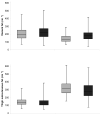Body fat distribution and inflammation among obese older adults with and without metabolic syndrome
- PMID: 20395951
- PMCID: PMC3095947
- DOI: 10.1038/oby.2010.86
Body fat distribution and inflammation among obese older adults with and without metabolic syndrome
Abstract
The protective mechanisms by which some obese individuals escape the detrimental metabolic consequences of obesity are not understood. This study examined differences in body fat distribution and adipocytokines in obese older persons with and without metabolic syndrome. Additionally, we examined whether adipocytokines mediate the association between body fat distribution and metabolic syndrome. Data were from 729 obese men and women (BMI ≥ 30 kg/m(2)), aged 70-79 participating in the Health, Aging and Body Composition (Health ABC) study. Thirty-one percent of these obese men and women did not have metabolic syndrome. Obese persons with metabolic syndrome had significantly more abdominal visceral fat (men: P = 0.04; women: P < 0.01) and less thigh subcutaneous fat (men: P = 0.09; women: P < 0.01) than those without metabolic syndrome. Additionally, those with metabolic syndrome had significantly higher levels of interleukin-6 (IL-6), tumor necrosis factor-α (TNF-α), and plasminogen activator inhibitor-1 (PAI-1) than individuals without metabolic syndrome. Per standard deviation higher in visceral fat, the likelihood of metabolic syndrome significantly increased in women (odds ratio (OR): 2.16, 95% confidence interval (CI): 1.59-2.94). In contrast, the likelihood of metabolic syndrome decreased in both men (OR: 0.56, 95% CI: 0.39-0.80) and women (OR: 0.49, 95% CI: 0.34-0.69) with each standard deviation higher in thigh subcutaneous fat. These associations were partly mediated by adipocytokines; the association between thigh subcutaneous fat and metabolic syndrome was no longer significant in men. In summary, metabolically healthy obese older persons had a more favorable fat distribution, characterized by lower visceral fat and greater thigh subcutaneous fat and a more favorable inflammatory profile compared to their metabolically unhealthy obese counterparts.
Conflict of interest statement
Figures



References
-
- Wang YC, Colditz GA, Kuntz KM. Forecasting the obesity epidemic in the aging U.S. population. Obesity (Silver Spring) 2007;15:2855–65. - PubMed
-
- Villareal DT, Apovian CM, Kushner RF, Klein S. Obesity in older adults: technical review and position statement of the American Society for Nutrition and NAASO, The Obesity Society. Am J Clin Nutr. 2005;82:923–34. - PubMed
-
- Karelis AD, St-Pierre DH, Conus F, Rabasa-Lhoret R, Poehlman ET. Metabolic and body composition factors in subgroups of obesity: what do we know? J Clin Endocrinol Metab. 2004;89:2569–75. - PubMed
-
- Wildman RP, Muntner P, Reynolds K, et al. The obese without cardiometabolic risk factor clustering and the normal weight with cardiometabolic risk factor clustering: prevalence and correlates of 2 phenotypes among the US population (NHANES 1999-2004) Arch Intern Med. 2008;168:1617–24. - PubMed
-
- You T, Ryan AS, Nicklas BJ. The metabolic syndrome in obese postmenopausal women: relationship to body composition, visceral fat, and inflammation. J Clin Endocrinol Metab. 2004;89:5517–22. - PubMed
Publication types
MeSH terms
Substances
Grants and funding
LinkOut - more resources
Full Text Sources
Medical
Miscellaneous

